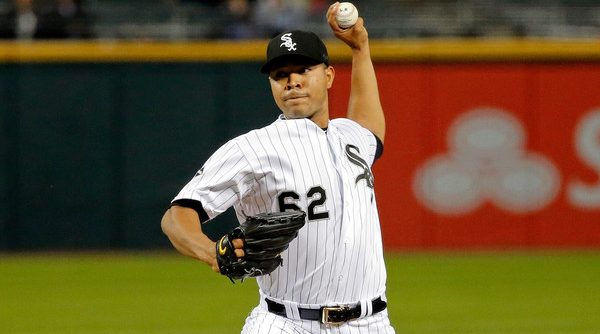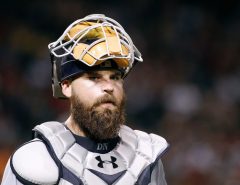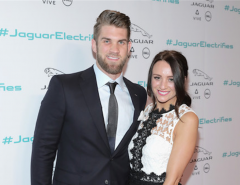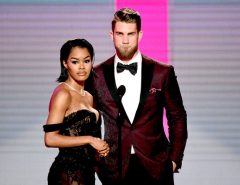As a college student home for Thanksgiving break, I have plenty of free time. And when I have plenty of free time in the offseason, I write about roster building. Borrowing an idea from Ryan Sullivan, AKA The Nats GM, I decided to do my own mock offseason, conducting trades and making signings to build a better 2017 Nationals team.
The only rule for this exercise will be that I will try to keep the team’s budget under $165 million. That’s almost exactly the team-record payroll in 2015, so it seems like a reasonable benchmark. But with projected arbitration salaries, we enter the offseason already owing $153 million, so I will need to stay cheap and cut some existing costs to hit that budget.
We’ll start with the least surprising move of the offseason.
Non-tender Ben Revere
2017 salary: $6.3 million (projected)
Revere was miserable in 2016, and a team with aspirations like the Nationals (and a tight budget like theirs) have can’t wait around to see if he’ll rebound. I’d be very surprised if he stuck around.
Trade Danny Espinosa
2017 salary: $5.3 million (projected)
Espinosa was his usual self in 2016: a miserable hitter with a great glove. That makes him a slightly below average starting shortstop, but he no longer has a place on the Nationals’ roster with the emergence of Trea Turner. Unless the Nationals decide they prefer Turner in center, Espinosa seems to be on the way out.
With one year of arbitration left at a projected salary of $5.3 million, Espinosa should have some decent trade value. He could return a good prospect or two, though I’ll trade him for a major league piece later in this article.
Acquire Jose Quintana for prospects
2017 salary: $7 million
Quintana is a stud. He has posted 18 bWAR and a 3.35 ERA in his past four seasons, culminating in his first All-Star appearance this year. He has thrown at least 200 innings four straight seasons, making him one of 12 pitchers to throw at least 800 innings since 2013. Of those 12, five have already won Cy Young awards. Quintana and Jeff Samardzija are the only ones who have not yet finished in the top-5 of Cy Young voting, and Quintana is the second-youngest behind Madison Bumgarner.
Quintana is a perfect fit for this roster. He’s an extremely good and dependable lefty with four years of team control left, and did I mention he’ll only be 28 next season? In a National League with the lefty-heavy Cubs and Dodgers, the Nats will need a strong lefty starter if they hope to find success in the playoffs. While Quintana isn’t at the same level as his teammate Chris Sale, he will come more cheaply and with an exta year of control.
As for the price: The Nationals have two top-10 global prospects in Lucas Giolito and Victor Robles, with Reynaldo Lopez not far behind. To evaluate how much a top-10 prospect fetches in trade, I decided to look at a few past examples. These were obviously few and far between, but I think they grant at least a little insight.
I found three such trades (excluding trades that took place at the trade deadline, when trade prices are higher). The first was a December 2005 trade that sent Andy Marte to Boston in exchange for three years of Edgar Renteria. Renteria was coming off four seasons in which he averaged 3.3 bWAR and was set to start the 2006 season at age 29, so he was still in his prime.
The second deal is one you’ve certainly heard of before: The December 2007 deal that sent Andrew Miller and Cameron Maybin (plus a few other smaller pieces) to the Marlins for Miguel Cabrera and Dontrelle Willis. Maybin was still a prospect, while Miller had lost his rookie eligibility during a difficult 2007 season with the Tigers. But between them, they fetched two years of a 25-year-old slugger with 18.2 bWAR and five seasons receiving MVP votes to his name and three years of a 26-year-old starter two years removed from being a Cy Young runner up.
The third deal should also sound familiar. In December of 2012, the Royals sent Wil Myers (and a few other prospects) to the Rays for James Shields and Wade Davis. While Myers was not the only piece going to Tampa, he was by far the biggest, and he brought back two years of a pitcher who had 8 bWAR over his past two seasons and came in third in the AL Cy Young vote in the prior of those two years. And that’s not to mention the five seasons of Davis, a struggling starter with great stuff who had spent the 2012 season as a dominant reliever.
Noticing a trend? One elite prospect can bring back multiple years of a borderline All-Star player, and two combined can fetch more than one young star. With these precedents in mind, I find it very hard to imagine the Nationals will part with more than one of those prospects in a trade.
But the Nationals have the prospect ammo to get a deal done regardless. I have absolutely no frame of reference for what would be a good deal beyond the prior examples laid out, so take this with a very big grain of salt, but I think a competitive offer for Quintana would look like this:
1. Choose one of Giolito or Lopez (I think Giolito is still broadly thought to be ahead, but they’re welcome to pick Lopez if they want. The Nats would also likely rather part with one of their boatload of near-MLB starters than their only big offensive prospect in Robles.)
2. Erick Fedde
3. One lower-level prospect (Andrew Stevenson, Drew Ward, etc., but perhaps not Austin Voth or AJ Cole for depth reasons)
I can also imagine a deal around Joe Ross, but a trade that involved losing him would certainly change the course of the offseason, including this next move…
Trade Gio Gonzalez for prospects
2017 salary: $12 million
Gonzalez is still a valuable lefty pitcher, with one relatively inexpensive year left on his contract and a vesting option for 2018 if he throws 180 innings in 2017. But he took a step back in 2016, with his ERA and FIP both jumping more than seven tenths of a run from 2015 to 4.57 and 3.76, respectively. There’s still reason to believe he will be a serviceable rotation piece next year: He’ll be just 31 in 2017, and he had an abnormally low runners stranded rate of 67.6 percent in. Strand rate is usually closer to 73 percent and is widely considered a product of luck.
But in our world, the Nationals have added Quintana to the rotation with Max Scherzer, Stephen Strasburg and Tanner Roark. Given that Mike Rizzo has already said Gonzalez will have to compete for one of the final two rotation spots with Ross, Giolito, Lopez, Voth, and Cole, he is certainly expendable with Quintana in the mix. He is valuable enough to bring a solid return, but his $12 million salary makes a big difference for a team pressing up against its budget, so a trade makes sense from a financial standpoint as well. And wouldn’t you know it: the New York Post reports that the Nationals are “aggressively” trying to trade Gonzalez.
The aim of trading Gonzalez is mainly to get his salary off the roster and reclaim some value, but he doesn’t necessarily have to go for prospects. If a trade of Gonzalez could bring back a piece that fills another need, as Ryan Sullivan wisely identifies by swapping Gonzalez for Miami’s Derek Dietrich in his mock offseason, it could make sense and preclude one of the other moves in this plan. But assuming that does not happen, Gonzalez could bring back a few nice prospects to somewhat refresh the system after the Quintana trade.
After these four moves, we’ve improved the team and brought our 2017 salary commitments way down to about $137 million. But we also haven’t addressed any of the Nationals’ main areas of need: Center field, closer, and catcher. Let’s do that, shall we?
Sign Dexter Fowler to a four-year, $80 million deal
2017 salary: $15 million
I won’t extol Fowler’s virtues again; you can read my argument for signing him in my outfield offseason preview. Suffice it to say that Fowler is a solid defensive center fielder with a decidedly above-average switch-hitting bat (though his splits indicate he’s better as a righty than a lefty). But our thriftiness above enables us to make one big free-agent splash at a position where our money goes further than it would with a closer. To save money for the 2017 budget, we’ll backload these multi-year deals.
Sign Greg Holland to a two-year, $18 million deal
2017 salary: $7 million
Having spent big money on Fowler, we find ourselves avoiding the top tier of expensive closers. Holland was one of the game’s best closers before missing 18 months after undergoing Tommy John surgery. He held a showcase in which his velocity was down from his usual numbers, but scouts came away satisfied. Even if Holland isn’t his past closer self, he will hopefully fit in among the other high-leverage relievers. A two-year deal seems like a nice compromise for the player and the team.
Acquire Tony Watson and a prospect for Danny Espinosa
2017 salary: $5.9 million (projected)
Instead of signing one big closer, we can hedge our bullpen bet and improve our depth by adding two excellent relievers. Watson put together three outstanding years from 2013 to 2015, with an ERA below 2 despite a 2.91 FIP. The lefty took over as Pittsburgh’s closer after they traded Mark Melancon to Washington but turned in a 3.06 ERA and 4.37 FIP, his highest since 2012 and 2011, respectively. He will be 32 next season and has lost almost 2 MPH on his fastball since 2014, but he remains a weapon against left-handed hitters. He held lefties to a .577 OPS last year, closely in line with his career .550 OPS allowed to them. With the health of Sammy Solis and the performance of Oliver Perez both questionable, Watson would provide some much-needed security to the left side of the Nationals’ relief corps.
The Pirates are currently set to start Jordy Mercer — he of the career .690 OPS and mediocre defense — at shortstop, making Espinosa a logical fit for them. They also just lost backup infielder Sean Rodriguez to free agency, creating a nice niche for Mercer to slide into on the bench. Watson has one year of arbitration control left at a projected salary of $5.9 million, almost the same as Espinosa’s. At equivalent salaries, it makes sense that the shortstop would be more valuable than the declining reliever, so we’ll say Pittsburgh adds a minor leaguer to get this done.
The addition of Watson also creates somewhat of a roster crunch in the bullpen. Shawn Kelley, Blake Treinen, Perez, and Solis are presumably already locks, and Holland and Watson make six. That group is still without a long man (my guess: Cole or Voth), who would be the seventh and final member. But that construction leaves young fireballer Koda Glover on the outside looking in. This all could be easily resolved if the new collective bargaining agreement gives teams a 26-man active roster, which the Nationals would certainly use to add another reliever, but if not, the team should look into trying to trade Perez, even if it means eating almost all of his salary.
Sign Alex Avila to a one-year, $1 million deal
2017 salary: $1 million
We’ve done a nice job of spending our financial and prospect capital to beef up the rotation, bullpen, and center field, but catcher is where we must pay the piper. Avila struggled through an injury-plagued year with the White Sox in 2016, but he showed some of what could make him valuable to the 2017 Nationals. He’s a career above-average hitter, and accomplished that through unconventional means in 2016. He hit .213/.359/.373, walking 18.2 percent of the time (more often than Bryce Harper!) but struck out a staggering 37.3% percent of the time. His offensive profile is basically an even more extreme Jose Lobaton with a little more power.
Avila accumulated 1.1 fWAR during his 57 games last season, but WAR only tells part of the story for catchers. He rated as a below-average framer, and Baseball Prospectus, which accounts for framing runs, rated him at just 0.1 WAR. On the other hand, Harry Pavlidis, then of ESPN, rated Avila as the second-best game caller in baseball, ahead of famed defensive ace Yadier Molina and trailing only pitcher whisperer AJ Ellis. While Pavlidis later acknowledged his game-calling metric was highly variable, it speaks highly of Avila that he was in the company of players like Ellis and Molina.
Avila is far from perfect. He has a long injury history and produces all his offensive value by getting on base, a profile that will certainly not mollify Nationals fans that bemoan the bottom of the order’s inability to drive in runs. But he seemingly checks the boxes for catcher intangibles and, at 30 years old, is not yet over the hill. In an weak catching market and with an extremely tight budget, Avila could provide some nice bang for their buck.
Sign Stephen Drew to a one-year, $4 million deal
2017 salary: $4 million
To round out our roster, we bring back a familiar face. Drew fills his own role from 2016 very well: backup who can play all over the infield with a nice lefty bat. His strong showing last season likely earns him a raise from the $3 million he made last year.
Without further ado — and at a tidy salary of $165.17 million — the 2017 Washington Nationals:
Rotation
Max Scherzer ($22.14 million)
Stephen Strasburg ($18.33 million)
Jose Quintana ($7 million)
Tanner Roark ($6.1 million)
Joe Ross ($500k)
Bullpen
Greg Holland ($7 million)
Tony Watson ($5.9 million)
Shawn Kelley ($5.5 million)
Oliver Perez ($4 million)
Sammy Solis ($500k)
Blake Treinen ($500k)
AJ Cole ($500k)
Koda Glover ($500k)*
*If teams have 26-man rosters under the new collective bargaining agreement
Lineup
Trea Turner SS ($500k)
Dexter Fowler CF ($15 million)
Bryce Harper RF ($9.3 million)
Anthony Rendon ($6.4 million)
Daniel Murphy ($12 million)
Jayson Werth LF ($21 million)
Ryan Zimmerman 1B ($14 million)
Alex Avila C ($1 million)
Pitcher
Bench
Stephen Drew SS ($4 million)
Jose Lobaton C ($1.6 million)
Chris Heisey OF ($1.4 million)
Clint Robinson 1B ($500k)
Michael Taylor CF ($500k)
Total: $165.17 million
Tags: AJ Cole, Alex Avila, Andrew Stevenson, Austin Voth, Ben Revere, Blake Treinen, Danny Espinosa, Dexter Fowler, Drew Ward, Erick Fedde, Gio Gonzalez, Greg Holland, Joe Ross, Jose Quintana, Koda Glover, Lucas Giolito, Nationals, Nats, Oliver Perez, Reynaldo Lopez, Sammy Solis, Shawn Kelley, Stephen Drew, Tony Watson, Trea Turner, Victor Robles, Washington Nationals





What would happen to Severino? Can they send him down?